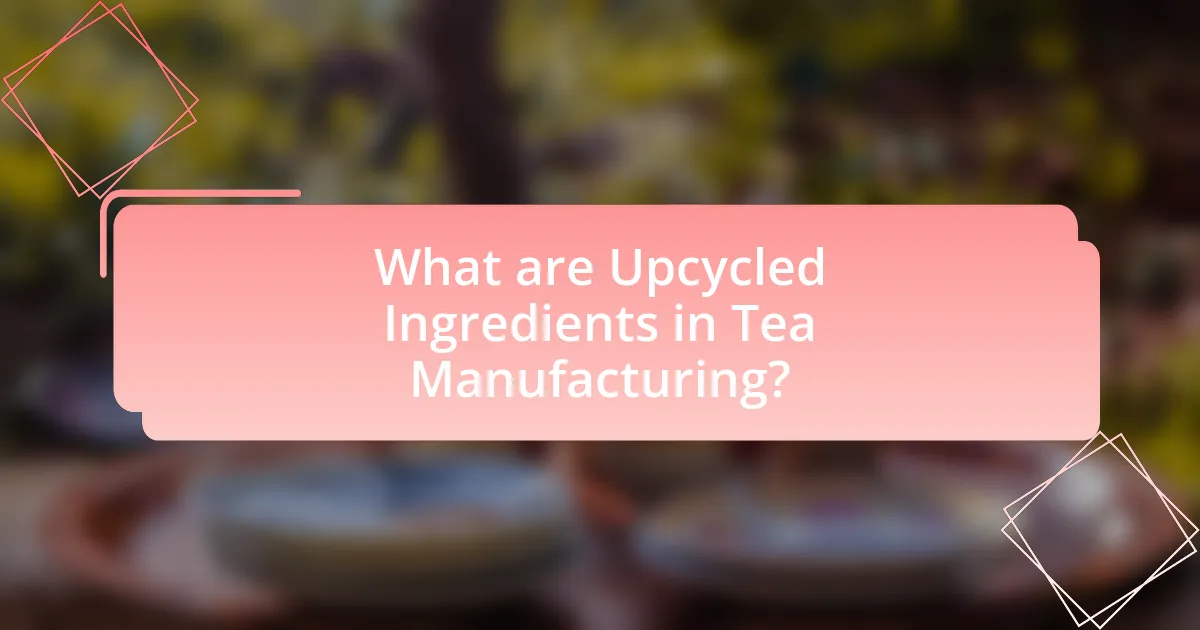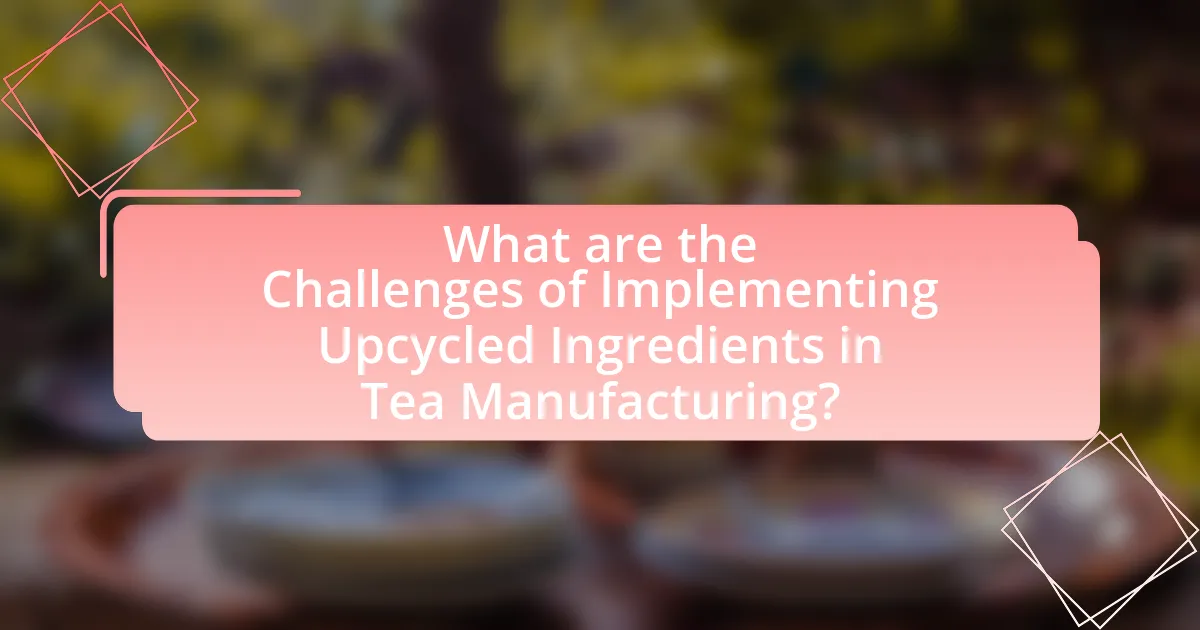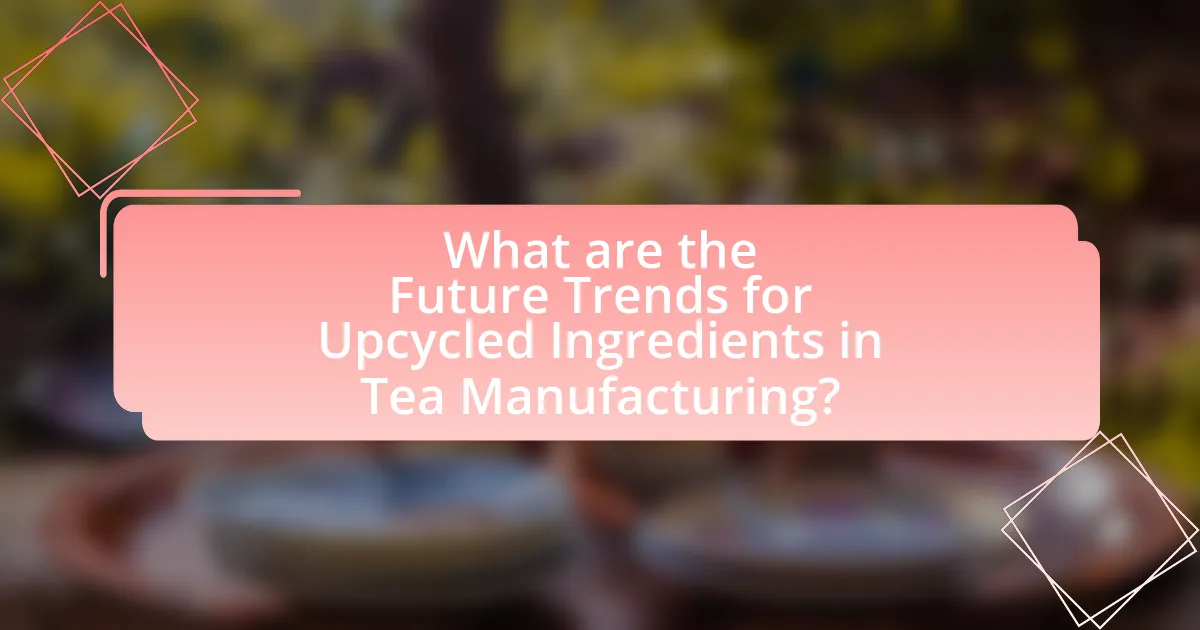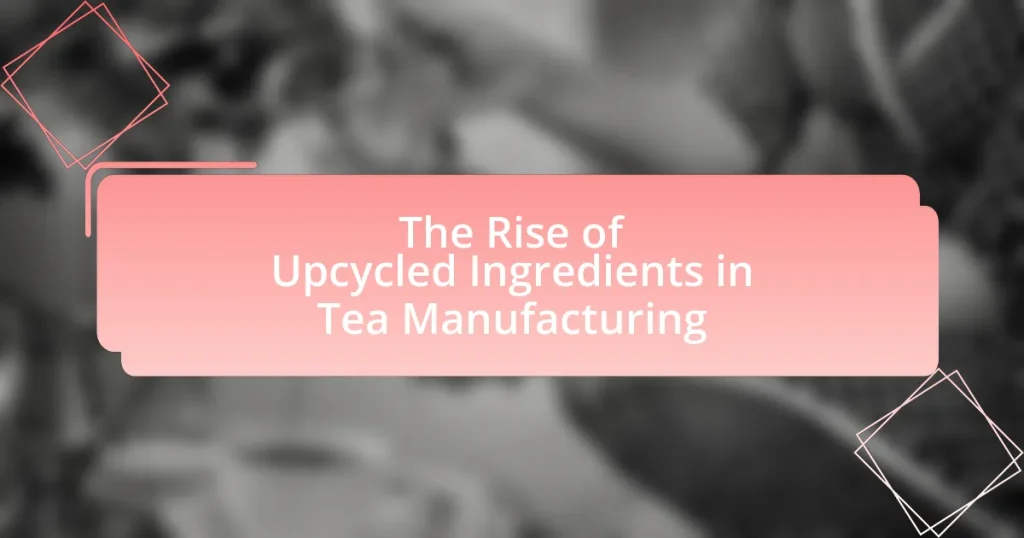The article focuses on the rise of upcycled ingredients in tea manufacturing, highlighting their role in enhancing sustainability and reducing waste within the industry. Upcycled ingredients, such as tea leaves, stems, and fruit peels, are repurposed from traditional production processes to create new tea products, thereby minimizing environmental impact. The article discusses the definition and types of upcycled materials, the benefits they provide, and the challenges manufacturers face in sourcing and implementing these ingredients. Additionally, it explores future trends, consumer preferences, and best practices for marketing upcycled tea products, emphasizing the importance of innovation and sustainability in the tea sector.

What are Upcycled Ingredients in Tea Manufacturing?
Upcycled ingredients in tea manufacturing refer to materials that would otherwise be discarded but are repurposed to create new tea products. These ingredients often include parts of plants, such as stems, leaves, and fruit peels, which are typically considered waste in traditional tea production. By utilizing these components, manufacturers can reduce waste and enhance sustainability in the tea industry. For example, upcycled citrus peels can be used to add flavor and aroma to tea blends, contributing to both environmental conservation and innovative product development.
How are upcycled ingredients defined in the context of tea?
Upcycled ingredients in the context of tea are defined as components derived from tea production processes that would otherwise be discarded or wasted, repurposed to create new tea products. This practice not only reduces waste but also enhances sustainability in the tea industry by utilizing parts such as stems, leaves, and other by-products that contribute to flavor and nutritional value. For instance, according to a study published in the Journal of Cleaner Production, upcycling can significantly lower the environmental impact of tea manufacturing by minimizing resource consumption and waste generation.
What types of materials are commonly upcycled in tea production?
Commonly upcycled materials in tea production include tea leaves, stems, and other plant by-products. These materials, often considered waste, can be repurposed into new products such as herbal infusions, flavoring agents, or even natural fertilizers. For instance, used tea leaves can be transformed into compost or incorporated into skincare products, demonstrating their versatility and value beyond the initial brewing process. This practice not only reduces waste but also enhances sustainability within the tea industry.
How does the upcycling process work in tea manufacturing?
The upcycling process in tea manufacturing involves repurposing tea by-products, such as stems, leaves, and dust, into new products that retain value. This process typically begins with the collection of these by-products during the tea production process, which are often discarded or considered waste. Instead of being thrown away, these materials are processed to create innovative products like herbal teas, flavoring agents, or even health supplements.
For instance, research indicates that upcycled tea leaves can be transformed into functional ingredients rich in antioxidants, which enhances their market value and promotes sustainability in the industry. This approach not only reduces waste but also contributes to a circular economy within tea manufacturing, aligning with growing consumer demand for sustainable practices.
Why is the use of upcycled ingredients gaining popularity in the tea industry?
The use of upcycled ingredients is gaining popularity in the tea industry due to increasing consumer demand for sustainable and environmentally friendly products. This trend is driven by a growing awareness of food waste and the desire to reduce environmental impact, as upcycling transforms by-products into valuable ingredients, thereby minimizing waste. For instance, tea brands are incorporating ingredients like spent tea leaves and fruit peels, which not only enhance flavor profiles but also contribute to sustainability efforts. According to a report by the Food and Agriculture Organization, approximately one-third of food produced globally is wasted, highlighting the importance of utilizing upcycled ingredients to combat this issue.
What environmental benefits do upcycled ingredients provide?
Upcycled ingredients provide significant environmental benefits by reducing waste and conserving resources. By repurposing food by-products that would otherwise be discarded, upcycling minimizes landfill contributions, thereby decreasing methane emissions associated with organic waste decomposition. Additionally, utilizing upcycled ingredients lessens the demand for new raw materials, which conserves water and energy used in agricultural production. For instance, a study by the Food Waste Reduction Alliance indicates that upcycling can reduce food waste by up to 30%, highlighting its potential to positively impact environmental sustainability.
How do consumer preferences influence the rise of upcycled ingredients?
Consumer preferences significantly influence the rise of upcycled ingredients by driving demand for sustainable and environmentally friendly products. As consumers become more aware of environmental issues, they increasingly seek products that minimize waste and promote sustainability, leading to a growing market for upcycled ingredients in various sectors, including tea manufacturing. For instance, a survey by the Food and Agriculture Organization found that 66% of consumers are willing to pay more for products made from upcycled materials, indicating a strong preference for sustainability. This shift in consumer behavior encourages manufacturers to innovate and incorporate upcycled ingredients, thereby aligning their products with consumer values and preferences.

What are the Challenges of Implementing Upcycled Ingredients in Tea Manufacturing?
The challenges of implementing upcycled ingredients in tea manufacturing include sourcing consistency, regulatory compliance, and consumer acceptance. Sourcing consistency is difficult because upcycled ingredients can vary in quality and availability, impacting product uniformity. Regulatory compliance poses challenges as manufacturers must navigate food safety standards and labeling requirements specific to upcycled products. Consumer acceptance is also a hurdle, as some consumers may be skeptical about the quality and safety of upcycled ingredients, necessitating education and marketing efforts to build trust. These challenges are supported by industry reports indicating that while upcycling can reduce waste, it requires careful management to ensure product integrity and market viability.
What obstacles do manufacturers face when sourcing upcycled ingredients?
Manufacturers face several obstacles when sourcing upcycled ingredients, including inconsistent supply, quality variability, and regulatory challenges. Inconsistent supply arises because upcycled ingredients often depend on the availability of surplus materials, which can fluctuate seasonally or based on market demand. Quality variability is a significant concern, as the nature of upcycled materials can lead to differences in composition and safety, making it difficult for manufacturers to maintain product standards. Regulatory challenges also complicate sourcing, as manufacturers must navigate complex food safety regulations that may not be well-defined for upcycled products, potentially hindering their ability to market these ingredients effectively.
How do quality control issues affect the use of upcycled ingredients?
Quality control issues significantly hinder the use of upcycled ingredients by compromising their safety, consistency, and overall quality. When upcycled ingredients are not subjected to rigorous quality control, they may contain contaminants or undesirable properties that can affect the final product’s safety and taste. For instance, a study published in the Journal of Cleaner Production highlights that inadequate quality assurance can lead to the presence of harmful substances in upcycled food products, which poses health risks to consumers. Furthermore, inconsistent quality can result in variability in flavor and aroma, undermining the reliability that consumers expect from tea products. Thus, effective quality control is essential to ensure that upcycled ingredients meet safety standards and maintain the desired characteristics in tea manufacturing.
What regulatory challenges exist for upcycled ingredients in tea?
Regulatory challenges for upcycled ingredients in tea include compliance with food safety standards, labeling requirements, and the need for clear definitions of what constitutes “upcycled.” Food safety regulations, such as those enforced by the FDA in the United States, require that all ingredients meet specific safety and quality standards, which can be difficult to verify for upcycled materials. Additionally, labeling regulations necessitate transparency about ingredient sourcing and processing, which can complicate marketing efforts. The lack of standardized definitions for upcycled ingredients further complicates regulatory compliance, as different jurisdictions may interpret these terms differently, leading to potential legal ambiguities and market access issues.
How can manufacturers overcome these challenges?
Manufacturers can overcome challenges in upcycled ingredient utilization by implementing innovative processing techniques and establishing strong supply chain partnerships. Innovative processing techniques, such as advanced extraction methods, can enhance the quality and flavor of upcycled ingredients, making them more appealing to consumers. Additionally, forming partnerships with local farmers and suppliers can ensure a steady supply of raw materials while promoting sustainability. Research indicates that companies adopting sustainable practices can see a 20% increase in consumer preference, highlighting the market potential for upcycled ingredients in tea manufacturing.
What strategies can be employed to ensure quality in upcycled tea products?
To ensure quality in upcycled tea products, implementing stringent sourcing and processing standards is essential. This involves selecting high-quality raw materials, such as tea leaves that are surplus or otherwise unsellable, and ensuring they are free from contaminants. Additionally, employing advanced processing techniques, such as proper drying and flavor extraction methods, can enhance the final product’s quality. Research indicates that maintaining traceability throughout the supply chain, from sourcing to production, significantly impacts product integrity and consumer trust. For instance, a study published in the Journal of Cleaner Production highlights that transparency in sourcing practices leads to higher consumer satisfaction and perceived quality in upcycled products.
How can collaboration with suppliers enhance the upcycling process?
Collaboration with suppliers can enhance the upcycling process by facilitating access to high-quality, surplus materials that can be repurposed in tea manufacturing. When suppliers share information about excess ingredients or by-products, manufacturers can identify opportunities to incorporate these materials into their products, thus reducing waste and promoting sustainability. For instance, a study by the Food and Agriculture Organization indicates that up to one-third of food produced globally is wasted, highlighting the potential for suppliers to provide valuable resources that would otherwise contribute to this waste. By working closely with suppliers, tea manufacturers can innovate new products, improve resource efficiency, and strengthen their sustainability credentials.

What are the Future Trends for Upcycled Ingredients in Tea Manufacturing?
Future trends for upcycled ingredients in tea manufacturing include increased adoption of innovative processing techniques, enhanced consumer awareness, and a focus on sustainability. Manufacturers are likely to implement advanced extraction methods to maximize the flavor and nutritional profiles of upcycled materials, such as tea leaves and fruit peels. Research indicates that the global upcycled food market is projected to reach $46.7 billion by 2028, reflecting a growing consumer preference for sustainable products. Additionally, brands are expected to emphasize transparency in sourcing and production, appealing to environmentally conscious consumers. This trend aligns with the broader movement towards reducing food waste and promoting circular economy practices in the food industry.
How is innovation shaping the future of upcycled ingredients in tea?
Innovation is significantly shaping the future of upcycled ingredients in tea by enhancing sustainability and product diversity. Advances in extraction technologies allow manufacturers to utilize by-products from tea processing, such as stems and leaves, which were previously discarded. For instance, companies are now developing methods to extract flavors and nutrients from these upcycled materials, creating new tea blends that appeal to health-conscious consumers. Research indicates that upcycling can reduce waste by up to 30%, contributing to a more sustainable tea industry. This shift not only minimizes environmental impact but also meets the growing consumer demand for eco-friendly products, thereby driving market growth in the sector.
What role does technology play in the upcycling process?
Technology plays a crucial role in the upcycling process by enabling efficient transformation of waste materials into valuable products. Advanced techniques such as data analytics, machine learning, and innovative processing methods allow manufacturers to identify potential upcycled ingredients, optimize extraction processes, and enhance product quality. For instance, in tea manufacturing, technology facilitates the extraction of flavors and nutrients from by-products like tea leaves and stems, which would otherwise be discarded. This not only reduces waste but also contributes to sustainability in the industry, as evidenced by studies showing that upcycling can decrease resource consumption by up to 30%.
How are consumer trends expected to evolve regarding upcycled tea products?
Consumer trends regarding upcycled tea products are expected to evolve towards increased demand and acceptance as sustainability becomes a priority for consumers. Research indicates that 66% of global consumers are willing to pay more for sustainable brands, highlighting a shift towards environmentally conscious purchasing behaviors. This trend is further supported by the growing awareness of food waste, with upcycled products being positioned as innovative solutions that contribute to sustainability efforts. As brands emphasize the environmental benefits and unique qualities of upcycled tea products, consumer interest is likely to rise, leading to broader market adoption and diversification of offerings.
What best practices should tea manufacturers adopt for upcycling?
Tea manufacturers should adopt best practices such as sourcing surplus tea leaves, utilizing by-products for new products, and collaborating with local businesses for waste reduction. Sourcing surplus tea leaves allows manufacturers to minimize waste while creating innovative blends, as demonstrated by companies that have successfully integrated leftover leaves into new tea varieties. Utilizing by-products, such as tea dust or stems, can lead to the development of value-added products like tea-infused snacks or cosmetics, which has been shown to enhance profitability and sustainability. Collaborating with local businesses can facilitate the repurposing of waste materials, creating a circular economy that benefits both the tea industry and the community. These practices not only reduce environmental impact but also align with consumer demand for sustainable products.
How can manufacturers effectively market upcycled tea products to consumers?
Manufacturers can effectively market upcycled tea products to consumers by emphasizing sustainability, health benefits, and unique flavor profiles. Highlighting the environmental impact of upcycling, such as reducing waste and conserving resources, appeals to eco-conscious consumers. For instance, a study by the Food and Agriculture Organization indicates that upcycling can significantly lower carbon footprints associated with food production. Additionally, showcasing the nutritional advantages of upcycled tea ingredients, like increased antioxidants from reused tea leaves, can attract health-focused buyers. Engaging storytelling about the sourcing and production process can also create a strong emotional connection with consumers, enhancing brand loyalty and encouraging purchases.
What are the key considerations for sustainability in upcycled tea production?
Key considerations for sustainability in upcycled tea production include sourcing practices, waste reduction, and environmental impact. Sourcing practices must prioritize high-quality, organic materials to ensure that the upcycled tea retains beneficial properties while minimizing chemical use. Waste reduction is critical, as upcycling aims to repurpose by-products from tea production, thereby diverting waste from landfills and promoting a circular economy. Additionally, assessing the environmental impact involves evaluating the carbon footprint of the entire production process, including transportation and processing methods, to ensure that upcycled tea contributes positively to sustainability goals. These considerations are essential for aligning upcycled tea production with broader environmental and social responsibility objectives.


